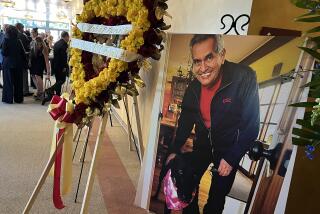Riding His Own Coattails : WILLIE BROWN: A Biography.<i> By James Richardson (California: $29.95, 417 pp.)</i>
- Share via
We worry about the scarcity of character in our politicians, so much so that we deem it an “issue.” But what about the equally unpardonable shortage of characters in America’s elective life?
Where are those who enliven the halls of government? Those who turn our heads? Those who aren’t shocked into obsequiousness by the latest tremor of public opinion and instantaneous accounting? Not the ideologues or demagogues, but the stylists with some voltage in them? Well, you say, there still is Willie Brown.
And thank heavens.
By any measure, Willie L. Brown Jr. is an extraordinary and consequential politician. And in the sterile landscapes at the end of our century, he’s unique. By that is meant, he is uniquely interesting.
So a biography of Brown, while timely, bears a special burden, as I see it. Can a writer dig out truths good and bad about such a grand character, probe and correct the myths, without destroying the mythology? Or, put another way, can Brown be drawn into perspective without cutting him down to size?
Yes, and James Richardson does it well: At a ripe moment, a craftsman conveys the artist, or certainly the public face of him.
This is the first book-length undertaking about Brown and arrives exactly as the worn-thin image of California’s most demonized politician has been freshly recharged. Instead of presiding as the speaker of a state Assembly in decline, Brown now presides as mayor of a rebounding and exuberant San Francisco.
And don’t forget the dripping irony of this: Republicans made the case for term limits to drive out power brokers like Brown, with the result of securing at least this one’s revival. The longest-serving speaker in state history, Brown didn’t want to leave the California Legislature; he was made to.
Richardson is a staff writer for the Sacramento Bee and he allows only once, at the very conclusion of this book, the unnerving sensation he felt in trying to grasp a “moving target.” Considering Brown’s flamboyance, his mastery of the squalid arts of political fund-raising and the long list of rivals he bested and ridiculed, it would have seemed just as probable for Brown today to be on the long fall downward as it is for him to be soaring up.
The suspense makes for zest--and balance--in Richardson’s account. He advances on his subject knowing that his last chapter just might have ended up entitled, “The FBI” instead of “Da Mayor.” After all, investigators have hungrily roamed the Capitol for years, picking off legislators and staff here and there. And no one is more appetizing to an earnest federal agent than this loudmouth liberal who flaunts his women, his cars, his Italian suits, his power and practically everyone else’s conventions. But the investigators never saw a chance with Brown, even though the system in which he prospered always seemed corrupting.
Brown might respond by saying that he never had a choice between a perfect world or the real world. Not from day one. Which Richardson, with his easy touch on the keyboard, recounts in the opening words of this biography:
“It cost $7 to bring Willie Lewis Brown Jr. into the world. His father paid the fee to Chaney Gunter, a Negro midwife who delivered him on March 20, 1934, in his grandmother’s drafty, whitewashed clapboard house in Mineola, Texas. . . .”
This is segregated, Depression-era East Texas, and Richardson makes better sense of Brown’s upbringing than even the storyteller Brown himself could.
Yes, he was raised poor--but not really as poor as you might think. Brown’s extended family included the important influence of entrepreneurs with the agility to survive in a wholly unequal world. Significantly, Richardson writes, Brown’s early memories were not of the harshest aspects of segregation but how to survive it.
Brown’s grandmother, and certainly his mother, Minnie, are known to those Californians who have followed Brown’s career closely. He loved hamming it up later in life for his mother. When I first met her in Texas in 1983, she was a visual symbol of the extremes in Brown’s life. She stood over the sink in her low-ceiling kitchen, the strap of a threadbare slip drooping down her arm, repaired with a safety pin, and over it a fantastically stylish and expensive boutique dress, a gift from her son.
Brown’s father, Lewis Brown, was, according to family lore, a railroad porter. That turns out to have been a handy way to excuse his absence. Richardson, who interviewed Lewis Brown at the end of his life, reveals instead a waiter with an uncommon gift to impress the well-do-do clientele.
The large core of Richardson’s book, the revealing heart of Willie Brown’s life, begins in San Francisco in 1951, when he was just another young dreamer stepping off the train in an important migration of blacks westward.
From then, life for Brown is utterly improbable and at the same time undeniably all-American. A jaunty bantamweight whose most commanding feature was his grinning motor-mouth, Brown landed himself in the swirl of civil rights activism and its new alliance with an emerging generation of white office-seekers who would carry on with him to shape California for decades.
Law school and the hierarchy of San Francisco’s Jones Methodist Church; the war in Vietnam and black militancy; the assassinations of Martin Luther King Jr. and Robert Kennedy, and then of his friend and predecessor San Francisco Mayor George Moscone; the mass suicides of the Jim Jones cult--all would test him.
Richardson’s story is not only of Brown, but of the modern political transformation of California, for both good and ill. The author presumes that we either want or need a spacious understanding of that era’s politics and characters--and there were plenty of characters then, from Ronald Reagan to former Speaker Jesse Unruh to San Francisco power brokers Phil and John Burton. At first, I wondered if Richardson was not lingering too long, but as I read along I came to see it his way: Brown is not only fascinating but he was shaped by fascinating times.
Maybe most intriguing of all has been Brown’s pioneering example of multiculturalism, which began long before there was such a word to describe it.
Ethnic politics is a fact and a force in modern America. Brown played but never specialized in it. The first African American elected to the Legislature from San Francisco owed his start not just to black voters but also to the white organizers and mentors who helped him. These were different worlds, and he chose to became part of both.
He dined not from a melting pot but from the kettle in one hand and the skillet in the other. And today, Brown stands alone as someone who can be described as one of the country’s most significant politicians and one of its most significant black politicians, depending on your point or his at the moment.
Where Richardson could easily have overdone his story, but coolly does not, is in the recounting of Brown’s long legislative career.
As speaker, Brown saw three governors and six Assembly Republican leaders. Any statehouse reporter can tell you, a lot happened in those years.
Richardson, however, is faithful to the single-mindedness of his subject. What moves all those bills and policies through the Capitol, what cuts up the pie in good times and bad, is the alignment of consensus with opportunity and self-interest. Or, as they say, the ability at any given moment to count to 41--which means commanding half of the votes in the state Assembly, plus one.
As retold here, and as it felt at the time for those who watched it, Brown’s quest to obtain the speakership, his audacity in holding it, has a near-epic quality. The hardball intensity of it, sometimes in the face of impossible odds, can take your breath away and make you wince at the same time. It was a bravura performance. Even his friends, though, believe the next sentence should begin, “But. . . .”
But what about the corrupting toll of perpetual fund-raising? Was the price he paid too high? The goal too narrow?
Richardson, however, has not written a judgmental biography. The writer seeks the story the way it was, not should’a, could’a, would’a. And I say, fine. Too often, public officials get our judgments ahead of our understanding. And I know for a fact that Brown’s wildly popular and unifying first 10 months as mayor have led to some revisionist back-pedaling by critics.
And surely part of his popularity is his mere presence on the stage. Which raises a final observation about this biography. Should the journalist have broached the private sides of Brown?
I, for one, wish he had. Except for passing mentions of his girlfriends, a cursory account of his estrangement from his wife, Blanche, and an aside that Brown arranges his own stereo systems, this oversized character remains blurry beyond one dimension. What music does he hear on that stereo? What does he do on his holidays to Italy? On what ideas does he meditate?
These are questions we ask of those who spark our imagination. And Brown has always insisted on doing that.
“You really have to have more than just a good heart. You also have to have some style,” he told “60 Minutes” correspondent Harry Reasoner in a 1984 interview recounted by Richardson. “. . . California is a media state. California is an image state. California is where it happens. You really--you really have to project something.”
Still, it’s perilous to fault a writer today for acknowledging the line between public and private. Many of his colleagues are going to the other extreme, and voters are feeling no better for it. There is plenty of Willie Brown on display as it is.
More to Read
Sign up for our Book Club newsletter
Get the latest news, events and more from the Los Angeles Times Book Club, and help us get L.A. reading and talking.
You may occasionally receive promotional content from the Los Angeles Times.









